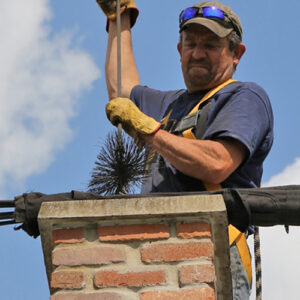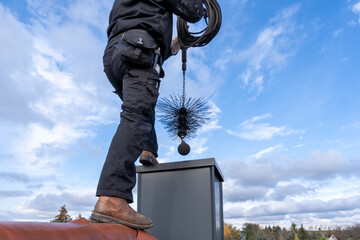If it’s been years since your chimney was last inspected, it could be caked in creosote or have hidden damage. Chimney Inspection Charleston SC can help prevent costly repairs and protect your home from the dangers of smoke or poisonous carbon monoxide.
A level 2 inspection includes all the areas surveyed in a level 1 inspection but also takes a closer look at the interior surfaces and joints of flue liners. This invasive inspection requires specialty tools and may require the removal of permanent portions of the chimney or building structure.
Chimneys and wood-burning fireplaces create a dangerous byproduct called creosote, which is a dark brown or black tar-like combustion byproduct. It can take the form of flaky, crusty, drippy, sticky, or hardened residue inside the chimney flue walls. Whatever its consistency or appearance, it is highly flammable and puts your home at risk in several ways.
In addition to a chimney fire, excessive creosote buildup can reduce how well and completely wood-burning fires burn. This is important because it impacts the efficiency of your heating system and negatively affects the air quality in your home.
If creosote is left untreated, it can deteriorate the metal flue liner and even cause the chimney to collapse or rot. As a result, it is a significant safety risk that can be easily avoided with regular chimney maintenance and inspections by certified professionals.
The Dangers of Creosote Buildup
Inhaling creosote residue in your fireplace or chimney is dangerous because it contains toxic chemicals that can damage the lungs. If it comes into contact with skin, it can also cause burning, stinging, and irritation. Creosote residue can also restrict the flow of smoke and gases from your fire, which can lead to poor ventilation in your home and health issues for your family.
There are three stages of creosote buildup, and each one poses different risks. Stage one, or first-degree creosote, is flaky and similar to ash. It is the simplest to remove from chimneys and can usually be removed as part of regular cleaning with a chimney brush. Stage two creosote is more sticky and tar-like, and it can be difficult to remove without more specialized equipment.
Once a chimney is full of second-degree creosote, it is extremely dangerous because it is less dense than soot and can be ignited by hot embers from the fire. It can also drip like candle wax and cause fires inside the chimney itself. Eventually, this can lead to a chimney fire that destroys the chimney and your home.
A CSIA-certified technician can identify excessive creosote buildup and determine whether a flue liner is necessary to help prevent it. They can also repair any components that promote creosote buildup, such as a warped or rotted damper that hinders proper closure and allows smoke to seep into the home.
Damage
Chimneys experience a great deal of wear and tear, just like other parts of your home. Over time, metal flue liners can corrode, and brick chimneys can crack and crumble.
These types of issues can be hard to detect without the help of a professional, but there are some warning signs that you should watch out for. If you notice white stains that appear on the exterior walls of your fireplace or in the firebox, it’s likely that there is excessive moisture in the masonry and your chimney needs a professional assessment. This is known as efflorescence, and it’s a sure sign that a leaky chimney is causing problems in your home.
A leaking chimney can be very dangerous because it can allow water to seep into the framing of your home and cause wood damage, mold growth, and other structural problems. If you notice any of these issues, contact your chimney sweep to schedule an appointment for a professional chimney inspection.
Another common type of damage that a chimney can suffer is the result of a chimney fire. When a chimney fire occurs, it can damage or destroy the masonry structure and compromise the safety of your home. Many homeowners’ insurance policies will cover damage caused by chimney fires, but only if the underlying damage is caught early on.
Chimney collapses are a serious issue, especially in seismically active areas. Bricks and stones can fall from the top of the chimney and cause structural damage to the roof and the inside of the home. Fortunately, there are steps that can be taken to prevent chimney collapses, including attaching plywood panels to the ceiling joists to act as a barrier between falling masonry and your living space.
In addition to routine chimney inspections, you should have a Level 2 inspection performed after any significant changes are made to the chimney system or after a dramatic weather event. This more in-depth inspection involves video scanning of the interior of the chimney to check for blockages and obstructions, as well as to examine the condition of the flue lining and its joints.
Carbon monoxide poisoning
Carbon monoxide (CO) is a colorless, odorless, and tasteless gas that is produced when fuels such as wood, coal, propane, natural gas, and kerosene burn. If these fuels are burned without proper ventilation, CO can leak into the home. CO poisoning is a serious health risk, particularly for infants, children, the elderly, and those with respiratory or heart conditions. It can even be fatal. A clogged chimney that prevents combustion gases from venting to the outside can allow dangerous levels of CO into the house. Carbon monoxide poisoning can be prevented with routine chimney maintenance and a working carbon monoxide detector.
During a chimney inspection, the chimney sweep will look for signs of a CO problem. This may include a blocked chimney that is forcing CO back into the home, a damaged flue liner that allows carbon monoxide to flow through the wall of the fireplace, or a rusty or cracked heat exchanger. They will also check the firebox to ensure that it is free of debris and that the chimney lining is intact.
If they suspect a carbon monoxide issue, they will need to do a Level 2 inspection. This involves the use of special tools to access concealed components such as the chimney crown and interior chimney walls. They will look for a corroded chimney structure, missing bricks, and structural damage, as well as check to make sure that the chimney cap and fireplace doors are intact and secure.
Carbon monoxide poisoning is a major concern for homeowners, but it can be easily avoided with regular chimney maintenance and a quality, battery-backed carbon monoxide detector. These simple steps, along with routine chimney sweepings and annual home inspections, can help ensure that your family stays safe and healthy.
Safety
As Benjamin Franklin wisely noted, “An ounce of prevention is worth a pound of cure.” This is particularly true when it comes to fireplaces and chimneys. The National Fire Protection Association and Chimney Safety Institute of America both recommend that homeowners have their fireplaces, wood stoves, and chimneys inspected annually to avoid costly damage and keep their families safe.
A professional chimney sweep can spot problems that the average person cannot. They are trained to look for things that may seem harmless at first, such as cracks in the chimney structure that could lead to a leak or signs of water damage on a chimney cap or flue liner. Chimney sweeps can also spot other issues that can lead to dangerous situations, such as creosote accumulation or the presence of carbon monoxide.
During an inspection, a professional chimney sweep will use a camera to look inside the fireplace and flue. They will also look at the exterior of the chimney for any problems, including deterioration or damage. This part of the inspection is very important, as one crack can compound rapidly, leaving much of the chimney brick in danger of crumbling.
In addition to looking at the interior of the chimney and flue, a chimney inspection should include a thorough check of the firebox. Often, the firebox is ignored and neglected, but a faulty firebox can cause fire hazards and leave your home vulnerable to smoke damage, chimney damage, and carbon monoxide poisoning.
A Level 2 chimney inspection includes everything in a Level 1 inspection, plus it will examine the accessible portions of the chimney interior, including attics, crawl spaces, and basements, and it will look for proper clearances from combustibles. This level of inspection is typically required when making changes to the fireplace or chimney system, such as a change in fuel type or an addition to the shape and size of the flue.
It is also a good idea to get a Level 2 chimney inspection prior to selling your home. This will ensure that the chimney is safe for the new owners and that the home inspector can point out any existing damage or vulnerabilities.
